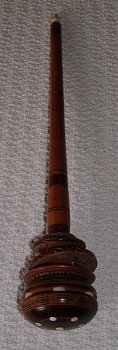Molinillo – Unique Chocolate Gift Idea
October 3, 2009
I like kitchen gadgets, baking tools, and small appliances. Sometimes I even use them! (lol). I especially love chocolate paraphernalia.

This tool was invented by the Spanish colonists in Mexico around the 1700's. The first molinillos were made to fit into a container with the handle sticking out of the top. Then the user would rapidly rotate the molinillo between his/her palms. The twisting motion frothed the chocolate.
Not only is this little cutie useful, but it loads of fun, too. And it looks cool! It starts many conversations because my friends have to ask what it is and what I use it for.
I have a couple different molinillos but one in particular, the one pictured here, has an interesting story behind it.
When my son was born, a very good friend of the family who happened to be a local antique dealer, presented us with a baby gift. She called it a Victorian era baby rattle. The rattle is made of wood with circular discs surrounding the “neck” of the rattle and decorated with inlaid ivory. It has a long handle with carved geometric designs, beautifully stained and varnished. It looks attractive and interesting. Kind of a funny looking rattle, though.
Years go by and one day I am looking online to find a Mexican Hot Chocolate recipe. Embedded in the recipe is a link to view the recommended tool of choice, the molinillo, to froth up the chocolate drink. When I clicked on the link, several photos of different styles of molinillos popped up and HOLY SMOKES! there is my Victorian era “baby rattle” working hard to put a creamy head of foam on a mug of hot chocolate! I always thought it was a funny looking rattle!
- BarkThins Dark Chocolate Coconut with Almonds - May 22, 2020
- Endangered Species Cacao Nibs + Dark Chocolate Review - May 15, 2020
- Mr. Dot Bar Review - May 7, 2020



Hello!
I inherited several of these from an elderly great aunt, and have always wondered about them – especially the ivory inlay. Have you learned any more about this specific one???
thank you!
Krista Ainsworth
Vermont